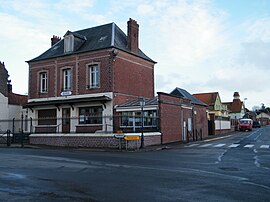Saint-Blimont
Appearance
Saint-Blimont | |
|---|---|
 The town hall and school in Saint-Blimont | |
| Coordinates: 50°07′18″N 1°34′30″E / 50.1217°N 1.575°E | |
| Country | France |
| Region | Hauts-de-France |
| Department | Somme |
| Arrondissement | Abbeville |
| Canton | Friville-Escarbotin |
| Intercommunality | CA Baie de Somme |
| Government | |
| • Mayor (2001–2008) | Claude Loiselle |
| Area 1 | 6.63 km2 (2.56 sq mi) |
| Population (2006) | 965 |
| • Density | 150/km2 (380/sq mi) |
| Time zone | UTC+01:00 (CET) |
| • Summer (DST) | UTC+02:00 (CEST) |
| INSEE/Postal code | 80700 /80960 |
| Elevation | 18–67 m (59–220 ft) (avg. 27 m or 89 ft) |
| 1 French Land Register data, which excludes lakes, ponds, glaciers > 1 km2 (0.386 sq mi or 247 acres) and river estuaries. | |
Saint-Blimont is a commune in the Somme department in Hauts-de-France in northern France.
Geography
The commune is situated 12 miles (19 km) west of Abbeville, on the D106 road. Sitting squarely between the industrial Vimeu region and the tourist regions of Picardie.
History
Closely linked with Saint-Valery-sur-Somme. The monk evangelist Saint Valery healed Blimond around 615, who succeeded him as head of the abbey at Saint-Valery-sur-Somme.
Population
| 1962 | 1968 | 1975 | 1982 | 1990 | 1999 | 2006 |
|---|---|---|---|---|---|---|
| 948 | 958 | 989 | 1056 | 1046 | 948 | 965 |
| Starting in 1962: Population without duplicates | ||||||
Places of interest
- The fifteenth century watchtower that has been a belltower for about 150 years. The tower is accessible in July and August, with guided visits every Saturday at 11 o'clock.
- The nineteenth century church, with interesting elements such as beams, a baptismal font originating from the previous sixteenth century church and a 15th-century statue of Saint Blimond.
See also
References
Wikimedia Commons has media related to Saint-Blimont.




